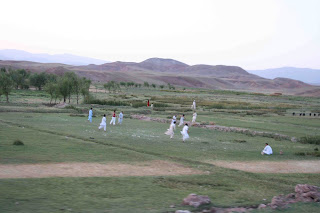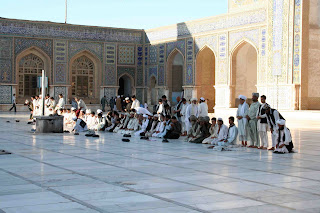
Welcome to the new Kiva Passport Series! Each month we will be featuring a new country to provide more insight into some of the remarkable places we work around the world.
 Map of Afghanistan
Map of Afghanistan
Photo Source: CIA The World Factbook
 Map of Afghanistan
Map of AfghanistanPhoto Source: CIA The World Factbook
Capital: Kabul
Official Language(s): Dari (Farsi) and Pashto
Government: Islamic Republic
Population (2009): 28,150,000
GDP (2009): PPP- $935 per capita; Nominal- $486 per capita
 Two weeks before this photo was taken the family lost their father/husband to gastrointestinal cancer
Two weeks before this photo was taken the family lost their father/husband to gastrointestinal cancer
Photo Credit: Jawid Habib
Photo Source: PROSPECT JOURNAL UCSD
 Midday Rest. June, 2009. Herat, Afghanistan
Midday Rest. June, 2009. Herat, Afghanistan
Photo Credit: Jawid Habib
Photo Source: PROSPECT JOURNAL UCSD
Afghan cuisine is a fusion of Mediterranean, Middle Eastern, Iranian and Indian flavors. A typical meal consists of rice served with a thick sauce cooked with lamb, beef or chicken. The classic Afghan dish, Qabili Palao, consists of raisins, carrots, and lamb with rice. With it's blend of flavors, Afghan cuisine is rich with the traditions of the region.
 People gathering at a local bazaar
People gathering at a local bazaar
Photo Credit: Jawid Habib
Official Language(s): Dari (Farsi) and Pashto
Government: Islamic Republic
Population (2009): 28,150,000
GDP (2009): PPP- $935 per capita; Nominal- $486 per capita
The landlocked country stands bordered by Tajikistan, Turkmenistan and Uzbekistan to the north, Iran to the west, Pakistan to the south, and the People's Republic of China to the east.
 Two weeks before this photo was taken the family lost their father/husband to gastrointestinal cancer
Two weeks before this photo was taken the family lost their father/husband to gastrointestinal cancerPhoto Credit: Jawid Habib
Photo Source: PROSPECT JOURNAL UCSD
The spread of poverty in Afghanistan is considerably focused in the rural and urban areas. According to the government, an estimated 42% of the population lives below the national poverty line, with nearly another 20% of the population attempting to balance on the line that puts them at risk of falling into poverty as well.
After the Soviet invasion in 1979, Afghanistan has become the epicenter for countless conflicts, invasions, and wars. The basic lack of resources has led the nation into a downward spiral towards poverty. With little arable land and poor climate conditions, Afghanistan's population has lost much of its livelihood. In a nation where 90% of women and 63% of men are unable to read and write, where there is inadequate land ownership, and where there is a lack of irrigation infrastructure, Afghanistan's population is undeniably poor.
 Midday Rest. June, 2009. Herat, Afghanistan
Midday Rest. June, 2009. Herat, AfghanistanPhoto Credit: Jawid Habib
Photo Source: PROSPECT JOURNAL UCSD
Indian, Central Asian and Iranian sounds have influenced Afghanistan's rich musical heritage. The rubab, a lute-like instrument, is considered to be the national instrument--called the "lion" of instruments.
Afghan cuisine is a fusion of Mediterranean, Middle Eastern, Iranian and Indian flavors. A typical meal consists of rice served with a thick sauce cooked with lamb, beef or chicken. The classic Afghan dish, Qabili Palao, consists of raisins, carrots, and lamb with rice. With it's blend of flavors, Afghan cuisine is rich with the traditions of the region.
 People gathering at a local bazaar
People gathering at a local bazaarPhoto Credit: Jawid Habib
A Night in Kohistan
By: Khalili
On the mountain's slope
The assembled trees form a dark green mass
The stars twinkle
And the moonlight adorns the Valley
It is a night of youth and love
From the grassy meads, covered with wild flowers
Where the nightingales sing
I hear the heavenly melody of the shepherd's flute
By: Khalili
On the mountain's slope
The assembled trees form a dark green mass
The stars twinkle
And the moonlight adorns the Valley
It is a night of youth and love
From the grassy meads, covered with wild flowers
Where the nightingales sing
I hear the heavenly melody of the shepherd's flute
PREVIOUS ARTICLE
Moving Forward in El Salvador →NEXT ARTICLE
Planting Trees with Schoolchildren – Social Responsibility in Microfinance →















